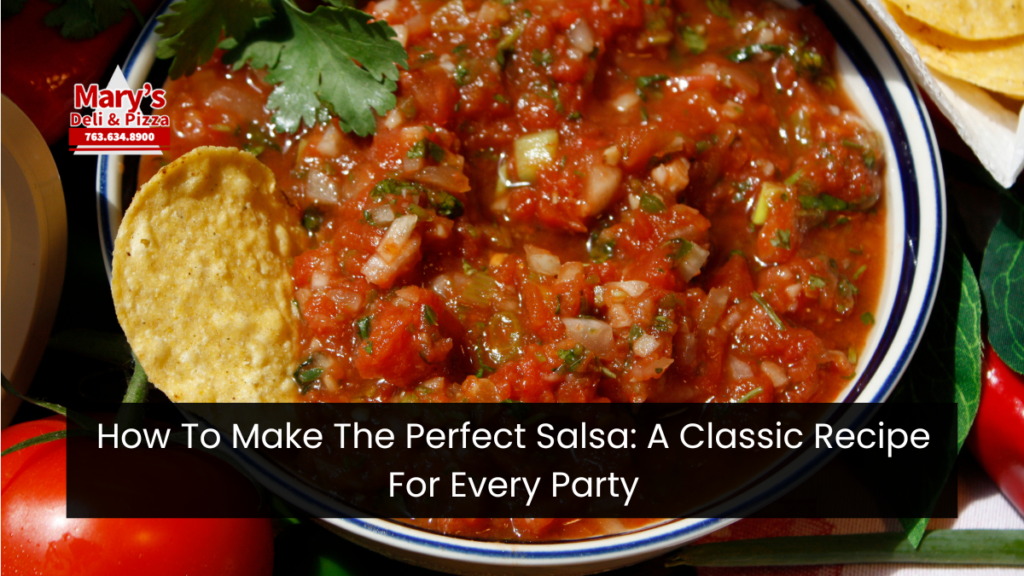Salsa is a staple appetizer that can elevate any gathering or meal. With its balance of fresh ingredients and robust flavors, it’s no wonder that salsa has become a party favorite. Whether you’re looking to add a zesty side to your nachos or a tasty topping for your tacos, this classic salsa recipe will quickly become your go-to. The best part? It’s incredibly easy to make and can be prepared in minutes, leaving you more time to enjoy the party.
In this article, we’ll take you through the steps of making a delicious salsa, explore the ingredients, and discuss how you can customize the spiciness to your liking. We’ll also answer some common questions to ensure your salsa comes out perfect every time.
Salsa Recipe Ingredients: A Fresh & Canned Tomato Mix
The foundation of this salsa recipe relies on a combination of both fresh and canned tomatoes to achieve a perfect balance of texture and flavor.
- Roma tomatoes (1 lb.): Fresh tomatoes add a vibrant and tangy flavor to the salsa. Make sure they are seeded and chopped.
- Canned diced tomatoes (15 oz. can): Canned tomatoes bring a rich, savory flavor that enhances the overall depth of the salsa.
- Yellow onion (1 cup, chopped): Adds a sweet yet slightly sharp flavor that complements the tomatoes perfectly.
- Jalapeño peppers (2 small, chopped): These provide the salsa with its kick of heat. For a milder salsa, remove the seeds.
- Cilantro (½ cup, chopped): This herb adds a fresh and bright flavor. If you’re not a fan of cilantro, you can replace it with a pinch of Mexican oregano.
- Garlic (2 cloves, chopped): Garlic provides an extra layer of depth to the flavor.
- Fresh lime juice (1 ½ tablespoons): Lime juice brings a refreshing acidity that brightens up the entire dish.
- Kosher salt (2 teaspoons): Enhances the flavors of all the ingredients.
- Sugar (optional): If the tomatoes are not fully ripe, a pinch of sugar can balance the acidity.
How To Make Salsa: Easy Steps To Follow
This homemade salsa recipe is incredibly simple and takes just a few minutes to prepare. All you need is a food processor to get started.
Step 1: Combine The ingredients
- Add all the ingredients—Roma tomatoes, canned tomatoes, onion, jalapeños, cilantro, garlic, lime juice, salt, and sugar (if needed)—into a large food processor. If your food processor is too small to hold everything at once, you can divide the ingredients into batches.
Step 2: Blend To Your Preferred Texture
- Pulse the food processor until all the vegetables are finely chopped. Be sure to scrape down the sides of the processor to ensure everything is well mixed. If you prefer a chunky salsa, blend less; for a smoother salsa, pulse a bit more.
Step 3: Chill For maximum Flavor
- Once blended, transfer the salsa to an airtight container and refrigerate for at least 4 hours. This step allows the flavors to meld together for a more cohesive and delicious result. You can also taste the salsa before serving and adjust the salt or lime juice as needed.
Customizing Your Salsa: From Mild To Spicy
Wondering how spicy or mild your salsa will be? The spiciness of the salsa is entirely up to you! The jalapeño peppers are the main source of heat in this recipe, and their heat levels can vary. Here are a few tips to control the spiciness:
- For a mild salsa: Remove the seeds from the jalapeños before adding them to the food processor.
- For medium heat: Leave some seeds in for a gentle kick.
- For a spicy salsa: Keep all the seeds or even add an extra jalapeño if you prefer more heat.
Can You Use Only Canned Tomatoes?
Absolutely! While fresh tomatoes offer a lovely, bright flavor, canned tomatoes are an excellent alternative if fresh tomatoes aren’t in season. You can use a 28-ounce can of whole peeled tomatoes as a substitute for the Roma tomatoes, but be sure to drain the liquid before adding them to the food processor.
What To Serve With Salsa: Perfect Pairings
Salsa is a versatile side dish that pairs well with a variety of foods. Here are some serving suggestions:
- Chips and salsa: A classic pairing that never gets old.
- Tacos: Salsa is an excellent topping for your favorite taco recipe.
- Nachos: Drizzle it over nachos for an extra burst of flavor.
- Grilled meats: Use salsa as a fresh topping for grilled chicken or steak.
- Burritos and quesadillas: Add salsa to your burrito or quesadilla for a zesty twist.
Storing Your Salsa: Refrigerate Or Freeze?
Refrigeration:
Homemade salsa can be stored in the refrigerator for up to 5 days. Make sure it’s in an airtight container, and give it a good stir before serving to redistribute any liquid that may have settled.
Freezing:
Yes, you can freeze salsa! However, it’s important to note that freezing may alter the texture and slightly diminish the fresh flavor. Here’s how to freeze salsa properly:
- Drain excess water before freezing: To prevent the salsa from becoming too watery upon thawing, pour the salsa into a fine mesh sieve and stir to remove excess liquid.
- Freeze for up to 1 month: Store in a freezer-safe container and freeze for up to a month. When thawing, drain any additional liquid, and use the salsa in cooked dishes rather than as a dip.
Conclusion:
This classic salsa recipe is incredibly versatile and easy to prepare, making it a must-have for any party or family meal. With a blend of fresh and canned tomatoes, balanced flavors from garlic, onions, and lime juice, and the flexibility to adjust the heat, you can tailor this salsa to suit any taste.
Whether you’re serving it as a dip, a taco topper, or a side for grilled meats, this salsa will quickly become a crowd favorite. Just remember to refrigerate it for a few hours to allow the flavors to meld, and you’ll have a delicious homemade salsa ready to impress your guests!
FAQs
1. How Do I Make My Salsa Less Watery?
To avoid watery salsa, use meaty tomatoes like Roma and drain canned tomatoes before blending. You can also strain out excess liquid after the salsa sits in the refrigerator.
2. How Do I Make Salsa Without A Food Processor?
If you don’t have a food processor, you can chop all the ingredients by hand for a chunkier salsa or use a blender for a smoother texture.
3. Can I Use Different Peppers Instead Of Jalapeños?
Yes! You can experiment with other peppers like serrano or habanero for more heat. If you prefer a mild salsa, try using bell peppers instead.
4. How Can I Sweeten Salsa Naturally?
If your salsa is too tart, you can add a pinch of sugar or a splash of honey or agave syrup to balance the acidity.
5. Can I Add Fruit To This Salsa Recipe?
Definitely! Feel free to add diced mango, pineapple, or peaches for a sweet and tangy twist.





